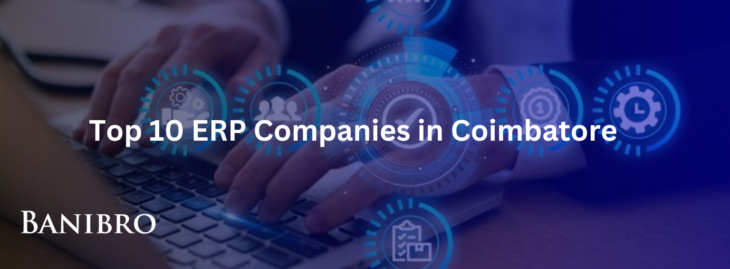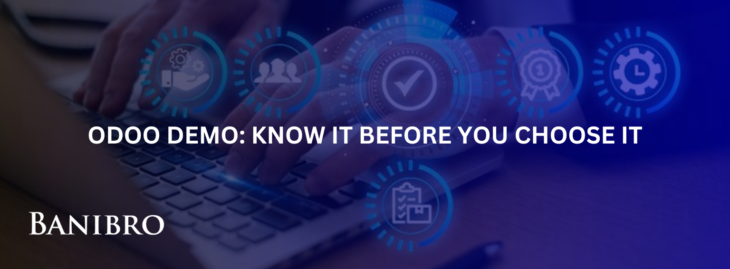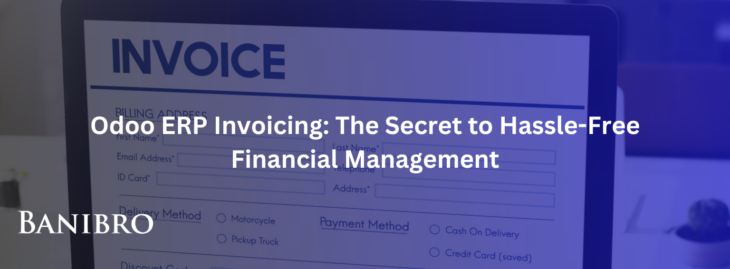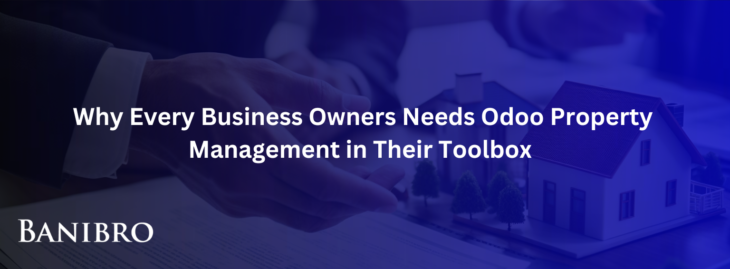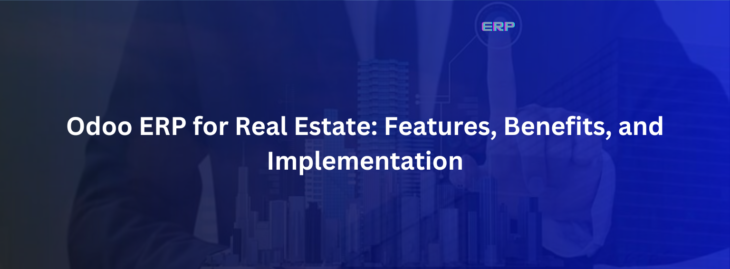5 Things You Didn’t Know About Odoo’s New Inventory Tools
5 Things You Didn’t Know About Odoo’s New Inventory Tools Introduction Odoo has long been recognized as a powerful all-in-one business management platform, offering tools for everything from accounting to CRM. The latest updates to Odoo inventory management tools take the system’s capabilities to a whole new level. These features not only improve stock handling but also streamline processes, making businesses more efficient and cost-effective. Here are five surprising things you might not know about Odoo’s new inventory tools. 1. Stock optimization for smart decision-making 2. Seamless integration with warehouse operations 3. Advanced reporting and analytics for better insights 4. Effortless management of returns with Odoo inventory 5. Enhanced support for multi-channel sales Stock optimization for smart decision-making One of the standout features in the latest Odoo Inventory tools is enhanced stock optimization. Businesses often struggle with striking a balance between overstocking and understocking. With the new inventory tools, Odoo ERP Software leverages to predict demand patterns based on historical data, market trends, and sales forecasts. Imagine automatically knowing the right amount of stock to order, minimizing waste, and reducing carrying costs. This not only saves money but ensures that your customers always find what they’re looking for. By optimizing inventory levels, businesses can also free up storage space and resources, which is especially beneficial for small and medium-sized enterprises. Enhanced integration with warehouse operations The management of one warehouse is already quite challenging, that means managing several warehouses is even more complicated. Odoo has resolved this issue with simplicity in tracking using real-time and synchronizing in multiple locations. You can get an overview of your entire inventory supply and make it easy to transfer your stocks from one warehouse to another or identify cases of stock out ages before they compromise your business. One of the important options in Odoo inventory management is its compatibility with barcode scanners and IoT devices, which precludes the risk of data input mistakes. Additionally, you can prioritize inventory movements based on demand, enabling smoother operations. For instance, if one warehouse gets closer to the end of a certain product, Odoo will suggest a transfer from another central hub instead of purchasing from the company. Advanced reporting and analytics for better insights The new Odoo Inventory tools come with improved reporting features that provide deeper insights into stock performance and trends. The advanced analytics dashboard offers metrics like stock turnover rates, most popular products, and seasonal trends, helping you make data-driven decisions. These insights are particularly useful for identifying inefficiencies in your supply chain. For example, if certain products are sitting in your warehouse for too long, you can take action by offering discounts or adjusting your purchase strategy. Moreover, the reporting tools are highly customizable, allowing you to focus on metrics that matter most to your business. Whether it’s tracking the success of your stock optimization efforts or evaluating supplier performance, the data is right at your fingertips. Effortless management of returns with Odoo inventory Odoo’s Inventory Returns feature streamlines the handling of customer and vendor returns, ensuring accuracy and efficiency. For customer returns, users can create Return Merchandise Authorizations (RMAs) directly from sales orders or invoices, ensuring proper tracking. Vendor returns link seamlessly to purchase orders, simplifying the process for defective or unwanted items. Key advantages include automated stock adjustments, integrated quality checks, detailed return reports, and reduced manual errors with barcode and IoT compatibility. These tools save time, enhance traceability, and improve relationships with customers and vendors, making returns management effortless and efficient. Enhanced support for multi-channel sales Today, businesses sell through multiple channels, including e-commerce platforms, physical stores, and third-party marketplaces. Odoo’s new inventory tools shine by providing unified inventory tracking across all sales channels. This ensures that your stock levels are accurate, no matter where your customers place their orders. For instance, if a customer buys an item from your online store, the inventory system automatically updates, so there’s no risk of overselling. Odoo also allows you to allocate stock for specific channels, ensuring priority fulfillment. This level of control makes it easier to manage promotions, reduce order cancellations, and build customer trust. Why choose Odoo for inventory management? Odoo inventory management is more than just a tool—it’s a comprehensive solution designed to adapt to the needs of modern businesses. From automating routine tasks to providing actionable insights, Odoo’s new inventory features empower businesses to stay ahead of the curve. If your goal is to minimize waste, optimize stock levels, and improve operational efficiency, Odoo’s latest updates are a game-changer. These tools not only save time and resources but also give businesses a competitive edge in a fast-paced market. Conclusion Odoo’s new inventory tools are packed with features that can transform how businesses manage their stock. If you haven’t explored the new features yet, now is the time. Upgrading your inventory management process with Banibro IT Solutions could be the key to unlocking greater efficiency and profitability in your business. With Odoo, inventory management isn’t just about tracking stock—it’s about building smarter, more agile operations. Curious to learn more? Let Banibro IT Solutions be your guide—reach out to us today!
Read MoreOdoo 18 is Live: Explore the Features That Will Drive Your Business Success
Odoo 18 is Live: Explore the Features That Will Drive Your Business Success As Odoo evolves, the release of version 18 brings a host of impressive updates and new features that streamline business operations across various departments. Whether you’re focused on sales, inventory management, accounting, or HR, Odoo 18 has something for everyone. Here’s a breakdown of the key innovations that make this release stand out: 1.Sales Enhancements: New Sales Commissions Module with customizable targets based on invoiced amounts, margin, or subscriptions. Flexible rule combinations for specific products, categories, or recurring periods. Strengthened Loyalty in Portal for enhanced customer retention. Combo Products available across PoS, Sales, E-commerce, and Subscriptions platforms. 2. Point of Sale (PoS) Upgrades: Backend views available directly in the frontend, allowing product creation within the PoS interface. Barcode lookup for faster and easier product identification. Free orders for PoS restaurants and improved UX on login and payment screens. 3. eCommerce Advancements: PDF Quote Builder 2.0 with translations, customizable fields, and editable zones. One-page checkout for a streamlined customer experience. Multiple warehouse support on a single website and stock visibility on product pages. Enhanced SEO tools and redesigned product pages for improved user engagement. 4. Inventory and Purchase Innovations: Delivery Dispatching with batch picking and vehicle assignments for delivery rounds. Revamped Barcode App with features like hiding reserved lots/serials and audible scanning confirmations. Purchase Templates and manual merging of RfQs for better procurement management. New shipping connectors for FedEx, DHL, and USPS with improved selection tools. 5. Manufacturing and MRP Improvements: Automatic Replenishment with flexible routing options. Enhanced Gantt views for better task management, zoom in/out options, and one-task-per-line views. Refactored MRP documents and improved Work in Progress Management for better tracking and documentation. 6. Service, Helpdesk, and Field Service Enhancements: Top bar navigation to easily browse related project records. Skills-based task assignments for better resource allocation. Helpdesk suggestions for similar tickets and relevant documentation. Field Service planning by location and product cost tracking in analytic accounting. 7. Accounting & Invoicing Upgrades: New Invoicing Dashboard for easier onboarding and enhanced features like layout previews. Improved tax selection guides and quick reconciliation using Kanban views. Bank synchronization with more providers and better batch payment matching. Enhanced Invoice Layouts with product descriptions in one column. 8. HR and Payroll Advancements: New Onboarding workflows and direct job board integration for recruitment. Payroll improvements include global CSV exports for banks and new overtime reporting. Fingerprint systems for better attendance management and approval of pending time-off requests. 9. CRM and Marketing Automation Features: Improved WhatsApp integration across multiple flows including inventory and marketing automation. Double-booking prevention in appointments and flexible seat-based pricing for bookings. Enhanced email composer and new tools for managing social sharing and marketing campaigns. 10. Knowledge and Collaboration Improvements: Clearer navigation in the Knowledge app, with advanced article search and Excalidraw integration. Discuss integration in Spreadsheets for improved communication and collaboration within financial reports. Editable pivot tables and dynamic options for customizing data in real time. Conclusion Odoo 18 is packed with powerful new tools and enhancements across the board, from sales and inventory management to marketing automation, accounting, and HR. These updates ensure that Odoo continues to be a comprehensive, integrated solution for businesses of all sizes, enhancing efficiency and productivity in every department. Whether you’re looking for more streamlined processes, better collaboration tools, or enhanced customer engagement, Odoo 18 delivers across the board. Reach out to us at info@banibro.com for further inquiries
Read MoreTop 10 ERP Companies in Coimbatore
Top 10 ERP Companies in Coimbatore Enterprise Resource Planning, better known as ERP, is a management software used by businesses around the world to easily manage their daily workflows. An effective ERP system helps in integrating basic functions happening within an organization and providing data on a single plane, facilitating easy access for management. These basic functions extend to HR, manufacturing, finance, inventory, logistics, etc. If you are looking for the best ERP service providers in Coimbatore, you have reached the right place. This article details the top 10 ERP companies in Coimbatore from whom you can avail the best services. 1. Banibro IT Solutions: Banibro IT Solutions was established in 2013. During the course of it’s growth as an Odoo service provider, they have served over 45 clients worldwide. As One of the top ERP software companies in Coimbatore & Chennai, their innovative team allows organizations to prosper in the digital age with cutting-edge technological solutions, with a focus on customized Odoo ERP development, mobile apps, and web applications. ERP Implementation: Yes ERP Customization: Yes Starting Price: Available on Request API Integration: Yes Mobile App: Yes ERP Demo: Yes Free Trial: Yes ERP Onsite/Inperson Support: Yes On premise/cloud: Both available Locations: Coimbatore, Chennai, United Arab Emirates, and the United States Website: www.banibro.com 2. ITtoALL : An expanding provider of IT services is situated in Coimbatore, Tamil Nadu, India.It offers solutions to all business sizes, softwares and IT solutions and more. They are dedicated in serving the corporate, technological and most valued solutions of the customers. Instead of expecting the customer to adapt to the product, ITtoALL thinks that their products should be tailored to the procedures used in the client’s organization. ERP Implementation: Yes ERP Customiaztion: Yes Starting Price: Available on Request API Integration: Yes Mobile App: Yes ERP Demo: Yes Free Trial: Yes ERP Onsite/Inperson Support: Yes On premise/cloud: Both available Locations: Coimbatore Website: www.ittoall.com 3. Skew Infotech: Skew Infotech is an IT service company that provides various specialized solutions including training, outsourcing, e-commerce sites, web hosting, and website design and development. Their customer base is their greatest asset; with their help, business connections, and business advice, they have improved day by day. High-calibre engineers at SKEW contribute to the company’s vibrant, receptive staff. The business places a high priority on its customers. They have always believed in giving their clients the best possible value in terms of cost, quality, dependability, and support. ERP Implementation: Yes ERP Customiaztion: Yes Starting Price: Available on Request API Integration: Yes Mobile App: Yes ERP Demo: Yes Free Trial: Yes ERP Onsite/Inperson Support: Yes On premise/cloud: Both available Locations: Coimbatore Website: www.skewinfotech.com 4. Samantha Technologies: Samantha Technologies is an web development and technology offshore outsourcing business layering every aspect of web design, IT outsourcing, and web development services for clients across globe. They play a major role in the various services in IT development including website design, e-commerce website design, CMS websites, mobile app development and marketing service including SEO services, brand identity creation and management, and digital marketing creating a specialized identity for their services. ERP Implementation: Yes ERP Customiaztion: Yes Starting Price: Available on Request API Integration: Yes Mobile App: Yes ERP Demo: Yes Free Trial: Yes ERP Onsite/Inperson Support: Yes On premise/cloud: Both available Locations: Coimbatore Website: www.samanthatechnologies.com 5. Konnect ERP: With its headquarters in Coimbatore, India, Konnect Analytics is a rapidly expanding product and consulting business that specializes in offering cloud-based Enterprise solutions. A group of professionals that have spent more than 15 years implementing ERP and other enterprise solutions for SMEs and larger businesses in manufacturing, oil and gas, retail, telecom, textiles, and many other industries founded Konnect in 2015. Excellent ERP, Business Intelligence (BI), and CRM solutions are provided by Konnect Analytics for all industries. ERP Implementation: Yes ERP Customiaztion: Yes Starting Price: Available on Request API Integration: Yes Mobile App: Yes ERP Demo: Yes Free Trial: Yes ERP Onsite/Inperson Support: Both available On premise/cloud: Both available Locations: Coimbatore Website: www.roadmapit.com 6. Roadmap IT: Roadmap IT provides solutions to various companies by digitalizing the workflows of the companies operations. Roadmap runs with ISO 9001:2015 and ISO 27001:2013 certifications, owing business professionals with more than 20 years of expertise in a variety of industries. They’re both On-Premises and On-Cloud implementations offer highly scalable and user-friendly ERP solutions that fits the unique needs of the customer, and they have the benefit of being an Oracle Gold Partner. ERP Implementation: Yes ERP Customiaztion: Yes Starting Price: Available on Request API Integration: Yes Mobile App: Yes ERP Demo: Yes Free Trial: Yes ERP Onsite/Inperson Support: Both available On premise/cloud: Both available Locations: Coimbatore Website: www.roadmapit.com 7. Inspire Network Technology Solutions: Inspire Networks built a dedicated commitment to help businesses to optimize their business efficiency by their expert services in Odoo customization, implementation, and support. They are reliable partners for transformation and efficient business management system in Chennai. ERP Implementation: Yes ERP Customization: Yes Starting Price: Available on Request API Integration: Yes Mobile App: Yes ERP Demo: Yes Free Trial: Yes ERP Onsite/Inperson Support: Both available On premise/cloud: Both available Locations: Coimbatore Website: www.inspirenetworks.in 8. Eresource: Eresource is a leading provider of ERP software solutions and fastest growing company in India offering On-the-Cloud, On-Premises, and cell phone-compatible ERP systems, they consistently strive to give clients to achieve the maximum operational excellence and top-quality enterprise solutions. ERP Implementation: Yes ERP Customiaztion: Yes Starting Price: Available on Request API Integration: Yes Mobile App: Yes ERP Demo: Yes Free Trial: Yes ERP Onsite/Inperson Support: Both available On premise/cloud: Both available Locations: Coimbatore, Chennai Website: www.eresourceerp.com 9. Otibro Techni Pvt. Ltd: One dedicated Odoo firm stands out for its customizations and support assistance is Otibro Solution. Otibro Solution navigates the complex world of enterprise resource planning with an emphasis on innovation and client-centricity, offering companies state-of-the-art technology and knowledge to optimize operations and spur long-term growth. ERP Implementation: Yes ERP Customiaztion: Yes Starting Price: Available on Request API Integration: Yes Mobile App: Yes ERP
Read MoreTOP 10 ERP Companies in Chennai
TOP 10 ERP Companies in Chennai Enterprise Resource Planning, better known as ERP Software, is a business management software designed to manage the overall business operations and tasks. ERP systems facilitate smooth integration and provides data on a single plane with functions extending to HR, manufacturing, finance, inventory, logistics, etc. If you are looking for the best ERP service providers in Chennai, this article finds you with the top 10 ERP companies in Chennai, to choose your right Odoo partner. 1. Banibro IT Solutions: Banibro IT Solutions was established in 2013. During its growth as an Odoo service provider, they have served over 45 clients worldwide. As one of the top ERP software companies in Chennai & Coimbatore, their innovative team allows organizations to prosper in the digital age with cutting-edge technological solutions, with a focus on customized Odoo ERP development, mobile apps, and web applications. ERP Implementation: Yes ERP Customization: Yes Starting Price: Available on Request API Integration: Yes Mobile App: Yes ERP Demo: Yes Free Trial: Yes The cloud and on-premises are both options. ERP In-person/Onsite support: Yes Locations: Chennai, Coimbatore, UAE, USA Website: www.banibro.com 2. Sage Software Solutions Pvt. Ltd: Sage Software Solutions works on the various insights of business management engaging clients to increase staff productivity, boost efficiency, deliver real-time business insights, strengthen teamwork, and address needs of the customers to maintain your finances under control, ensure efficient supply chain management, provide efficient insights, enable data-driven functions, and engage customer relationships. ERP Implementation: Yes ERP Customization: Yes Starting Price: Available on Request API Integration: Yes Mobile App: Yes ERP Demo: Yes Free Trial: Yes ERP Onsite/Inperson Support: Yes On-Premise/Cloud: Both available Locations: Chennai, Bangalore, Delhi, Mumbai Website: www.sagesoftware.co.in 3. Ramco ERP: Ramco Systems Limited is an Indian multinational software company that stands as the administrative centre in providing services across various sectors including areas of Aviation, ERP, HRP, and Logistics software. They cover a wide range of operations of enterprise solutions listing asset management, production, finance, supply chain management, project management, facility management, and much more. ERP Implementation: Yes ERP Customization: Yes Starting Price: Available on Request API Integration: Yes Mobile App: Yes ERP Demo: Yes Free Trial: Yes ERP Onsite/Inperson Support: Yes On-Premise/Cloud: Both available Locations: Chennai, Bengaluru, Gurugram, Madurai, USA, UK, Germany, U.A.E, Africa Website: www.ramco.com 4. eNoah : eNoah provides BPO and IT solutions globally which is both ISO 27001-certified and HIPAA-compliant, offering support services to many more organizations in the fields of integrated health, insurance, manufacturing, and automotive. The company strive to give the maximum efficiency to customers by providing the customer-centric IT solutions with proficiency in quality, reliability, and delivery. ERP Implementation: Yes ERP Customization: Yes Starting Price: Available on Request API Integration: Yes Mobile App: Yes ERP Demo: Yes Free Trial: Yes ERP Onsite/Inperson Support: Yes On-Premise/Cloud: Both available Locations: Chennai, Coimbatore, Indore, Bengaluru, USA, Singapore Website: www.enoahisolution.com 5. Amitysoft Technologies Pvt. Ltd: Amitysoft Technologies Private Limited excels in the mission to offer innovative, flexible, and cost-effective solutions that increase value for stakeholders. They mark themself as the strong foundation providing successful IT services to clients around the world. ERP Implementation: Yes ERP Customization: Yes Starting Price: Available on Request API Integration: Yes Mobile App: Yes ERP Demo: Yes Free Trial: Yes ERP Onsite/Inperson Support: Yes On-Premise/Cloud: Both available Location: Chennai Website: www.amitysoft.com 6. Agaram Infotech: Agaram InfoTech stands out to provide ideal solutions to customers around the globe satisfying the unique needs. They help your company to acquire the efficient business material with reasonably priced ERP software development services and support in this digital era. ERP Implementation: Yes ERP Customization: Yes Starting Price: Available on Request API Integration: Yes Mobile App: Yes ERP Demo: Yes Free Trial: Yes ERP Onsite/Inperson Support: Yes On-Premise/Cloud: Both available Location: Chennai Website: www.agaraminfotech.com 7. Datanote : DataNote is the top enterprise solution in India, assisting companies in implementing cloud-based ERP systems and fostering scalability while also guaranteeing the privacy of their data by preventing sharing with any third parties, including implementation partners. As opposed to traditional ERP implementation, Datanote’s current technology offers Open Logic Framework, which allows businesses to avoid disclosing all of their data, business logic, trade secrets, operational logic, and formulas. ERP Implementation: Yes ERP Customization: Yes Starting Price: Available on Request API Integration: Yes Mobile App: Yes ERP Demo: Yes Free Trial: Yes ERP Onsite/Inperson Support: Yes On-Premise/Cloud: Both available Locations: Chennai, Ahmedabad Website: www.datanote.in 8. Rednote : Rednote, a company based in Chennai, is responsible for the development and design of Rednote. A group of businesspeople founded Fragua Technologies in 2016 to offer top-notch software services to customers in India. Because of the high calibre of their software and customer service, Fragua Technologies has more than 600 customers in India. Rednote was created specifically to offer affordable, straightforward bills. It offers all the functions that are necessary for every business, not just invoices. ERP Implementation: Yes ERP Customization: Yes Starting Price: Available on Request API Integration: Yes Mobile App: Yes ERP Demo: Yes Free Trial: Yes ERP Onsite/Inperson Support: Yes On-Premise/Cloud: Both available Location: Chennai Website: www.rednote.in 9. Roadmap IT : Roadmap IT provides solutions to various companies by digitalizing the workflows of the company’s operations. Roadmap runs with ISO 9001:2015 and ISO 27001:2013 certifications, owing business professionals with more than 20 years of expertise in a variety of industries. They’re both On-Premises and On-Cloud implementations offer highly scalable and user-friendly ERP solutions that fits the unique needs of the customer, and they have the benefit of being an Oracle Gold Partner. ERP Implementation: Yes ERP Customization: Yes Starting Price: Available on Request API Integration: Yes Mobile App: Yes ERP Demo: Yes Free Trial: Yes ERP Onsite/Inperson Support: Yes On Premise/Cloud: Both available Location: Chennai Website: www.roadmapit.com 10. Otibro Techni Pvt. Ltd: Otibro stands out as the leading provider of various domains such as web application development, digital marketing, mobile app creation, and Odoo ERP software. We are dedicated to offer solutions to businesses of all sizes to
Read MoreTop 10 Odoo Partners in India
Top 10 Odoo Partners in India In the dynamic landscape of enterprise resource planning (ERP), Odoo defines its performance of streamlined operations for businesses with most flexible solutions excelling in Odoo implementation and odoo customization across various companies. Let’s explore into the top 10 Odoo partners in India that redefines business processes and stand out a way for efficient operations 1. Banibro IT Solutions: Positioned as one, Banibro IT Solutions is one of the leading Odoo partners in India. Banibro is an Odoo transformative system where it strives to provide a unified Odoo ERP service across the world, exceeding 50+ clients. They provide solutions to help businesses to stand out as outstanding teams of achieving greater operational efficiency in this digital era. Odoo Community Version: Yes Odoo Enterprise Version: Yes Odoo Partner: Yes Odoo Customization: Yes Odoo Demo Available: Yes Odoo Onsite Support: Yes Odoo in-person support: yes On premise/cloud: both available Locations Chennai, Coimbatore, United Arab Emirates, and the United States Website: www.banibro.com 2. SerpentCS: Standing tall as one of the top Odoo service providers in India is SerpentCS. Known for its dedication to quality and innovation, SerpentCS has helped clients in a variety of sectors alter their business operations. Odoo Community Version: Yes Odoo Enterprise Version: Yes Odoo Partner: Yes Odoo Customization: Yes Odoo Demo Available: Yes Odoo Onsite Support: Yes Odoo in-person support: yes On premise/cloud: both available. Locations: Gandhinagar, Gujarat Website: www.serpentcs.com 3. Emipro Technologies: Emipro Technologies has engaged itself as an Odoo provider providing top solutions to companies to improve their ERP experiences focusing on customer satisfaction by the team of knowledgeable experts. Odoo Community Version: Yes Odoo Enterprise Version: Yes Odoo Partner: Yes Odoo Customization: Yes Odoo Demo Available: Yes Odoo Onsite Support: Yes Odoo in-person support: yes On premise/cloud: both available. Location: Rajkot, Gujarat Website: www.emiprotechnologies.com 4. Caret IT Solutions: Customization is synonymous with Caret IT Solutions. What has distinguished them is their ability to customize Odoo solutions to each client’s specific demands. When it comes to implementing customized ERP systems, Caret IT Solutions is a reliable partner for companies. Odoo Community Version: Yes Odoo Enterprise Version: Yes Odoo Partner: Yes Odoo Customization: Yes Odoo Demo Available: Yes Odoo Onsite Support: Yes Odoo In-person support: Yes On premise/cloud: both available. Locations: Gandhinagar, Gujarat Website: www.caretit.com 5. Cybrosys Technologies: Cybrosys Technologies has led the way in utilizing technology to close gaps in operations. Cybrosys, an Odoo development specialist, is renowned for its creative solutions that smoothly optimize corporate processes. Odoo Community Version: Yes Odoo Enterprise Version: Yes Odoo Customization: Yes Odoo Demo Available: Yes Odoo Onsite Support: Yes Odoo In-person support: Yes On premise/cloud: Both available. Locations: Malappuram, Kerala Website: www.cybrosys.com 6. Brainvire Infotech Inc: Brainvire Infotech Inc. delivers top-tier solutions by their innovative ideas and functionalities providing businesses aiming for technological advancement with the knowledge of Odoo ERP implementation. Odoo Community Version: No Odoo Enterprise Version: Yes Odoo Partner: Yes Odoo Customization: Yes Odoo Onsite Support: Yes Odoo In-person support: Yes On premise/cloud: Both available. Location: Pune, Ahmedabad, Mumbai, USA, Canada, UAE, Kuwait, Dubai Website: www.brainvire.com 7. Kanak InfoSystems LLP: Kanak InfoSystems LLP emerged by adapting Odoo service emphasizing to give full potential to customers to increase the highest efficiency and made itself a reliable business partner for companies in a variety of industries. Odoo Community Version: Yes Odoo Enterprise Version: Yes Odoo Customization: Yes Odoo Demo Available: Yes Odoo Onsite Support: Yes Odoo In-person support: yes Locations: Delhi, Gujarat Website: www.kanakinfosystems.com 8. TechUltra solutions: TechUltra Solutions Pvt. Ltd. is an expert in using the powerful ERP solutions from Odoo to optimize business operations. Their skilled team guarantees maximum performance, boosting efficiency and giving firms a competitive edge—from smooth integration to configurable modules. Odoo Community Version: Yes Odoo Enterprise Version: Yes Odoo Demo Available: Yes Odoo Onsite Support: Yes Odoo In-person support: yes On premise/cloud: Both available. Location: Bangalore, Australia, USA Website: www.techultrasolutions.com 9. Oodles Technologies: Oodles Technologies is an IT firm that performs a critical role in the field of Odoo implementation turning ideas into reality for businesses aiming to get the highest efficiency. Odoo Community Version: Yes Odoo Enterprise Version: Yes Odoo Customization: Yes Odoo Demo Available: Yes Odoo Onsite Support: Yes On premise/cloud: Both available Locations: India, Singapore, Australia, India Website: www.oodlestechnologies.com 10. Otibro Solutions: One dedicated Odoo firm stands out for its customizations and support assistance is Otibro Solution. Otibro Solution navigates the complex world of enterprise resource planning with an emphasis on innovation and client-centricity, offering companies state-of-the-art technology and knowledge to optimize operations and spur long-term growth. Odoo Community Version: Yes Odoo Enterprise Version: Yes Odoo Customization: Yes Odoo Demo Available: Yes Odoo Onsite Support: Yes Odoo In-Person Support: Yes On premise/cloud: Both available. Locations: Chennai, Coimbatore, UAE, USA Website: www.otibro.com Conclusion: To sum up, these top ten Odoo partners in India are catalysts for corporate change rather than just service providers. In the cutthroat field of ERP solutions, their dedication to quality, creative solutions, and client happiness have cemented their positions. Partnering with a reliable Odoo service provider becomes more than simply a choice—rather, it becomes a strategic need as organizations continue to embrace digital transformation.
Read MoreODOO DEMO: KNOW IT BEFORE YOU CHOOSE IT
ODOO DEMO KNOW IT BEFORE YOU CHOOSE IT Businesses tend to move towards success where effective management and optimized workflows are essential in this rapidly evolving market demand. To manage those effective and multiple operations with more flexibility and adaptability Odoo ERP stands out as the prominent resource used across various industries owing to its user-friendly interface and wide range of functionality. The Odoo demo is a path way to get to know this powerful ERP software. It offers a virtual tour that showcases its wide range of features. You’ll experience live interactive demonstrations, easy navigation, and real-time communication options that highlight just how versatile Odoo can be. Whether you run a large enterprise or a small startup, the demo shows how you can customize the software to meet your specific business needs. It’s a great way to explore all the possibilities Odoo has to offer! Types of Odoo Demos Odoo demos can be of various types and can be selected in accordance with the specific needs of your business. Let’s take a look at the different kinds of Odoo demos available. 1) Odoo Enterprise Demo: The Odoo Enterprise Demo is designed exclusively for enterprise level sectors, to optimize and improve business operations for global enterprises. Odoo platform offers a wide range of features and capabilities that are accessible to improve productivity, communication, and decision-making at the enterprise level. 2) Odoo Community Demo: Odoo Community Demo brings a cost effective choice for small enterprises and startups. This community demo has successfully tailored to the businesses to optimize and engage high efficiency operations. 3) Odoo Manufacturing Demo: Manufacturing businesses get the most effective resources for the business management system by this particular demonstration. This shows how Odoo transforms, automates and optimizes wide manufacturing processes, from resource planning to quality control. 4) Odoo E-Commerce Demo: The Odoo E-Commerce Demo is essential for firms involved in online commerce. Get to know more about the seamless integration of sales, inventory, and customer administration with Odoo, which gives your customers a superior shopping experience. 5) Odoo Accounting Demo: Using the Odoo Accounting Demo can help you manage your finances more simply. Learn about the intuitive design and several tools that facilitate simple bookkeeping, billing, and logical financial analysis. 6) Odoo CRM Demo: The successful pathway of business holds in the strong client relationships, Odoo CRM Demo highlights how Odoo can actually deal with leads and customer inquiries, which in turn boosts with trusted customers and increase in revenue. 7) Odoo 13 Demo: Odoo 13 Demo functions with listed advanced features and developments. Trail Odoo 13 Demo for your business operations and enhance your efficiency by utilizing the top-tier functionalities. 8) Odoo 16 Demo: The Odoo 16 edition represents the future of ERP. It provides a preview of its cutting-edge features and improvements. Find out how the operations of your company might be transformed by Odoo 16. 9) Odoo POS Demo: The Odoo POS Demo for retail organizations shows how Odoo’s Point of Sale system can speed up payment processing, order management, and sales processes, enhancing retail efficiency as a whole. 10) Odoo Inventory Demo: The Odoo Inventory Demo teaches you how to manage accepted orders effectively and optimize stock levels. The various solutions available on Odoo to improve inventory management are highlighted in this demo. To Conclude: Odoo demo offers a diverse solution for businesses to choose the kind of demo wisely. It helps in enhancing your business’s work flow and further increasing sales and, thereby, profits. Explore the many capabilities provided by Odoo, its user-friendly interface, and its ability to be customized to meet your unique business needs by taking a virtual tour through these demos. Accept the strength of Odoo ERP and open up a world of possibilities for your business.
Read MoreTop 10 Cloud ERP Companies in Chennai
Top 10 Cloud ERP Companies in Chennai In the dynamic realm of business, maintaining a competitive edge necessitates effective resource management, optimized processes, and immediate insights. Cloud-based ERP Software systems prioritize as the transformative force for business seeking for their operational success. Chennai has emerged as the major center for technological standards. This article lets you know about the leading ten Cloud ERP enterprises in Chennai that redefines your business landscape. 1. Banibro IT Solutions: Founded in 2013, Banibro IT Solutions has grown to serve a global clientele exceeding 45 clients. Our team empowers businesses to thrive in the modern era through advanced technological offerings. We prioritize Odoo ERP implementation, along with the creation of mobile applications, establishing ourselves as one of the best top 10 cloud ERP companies in Chennai. Services: ERP Implementation, ERP Customization, ERP Consulting, ERP Development, ERP Integration, ERP Customization, ERP Configuration, ERP Maintenance, ERP Support ERP Licensing, ERP Hosting, ERP Training, ERP Migration. Specialized Industries : Insurance, Finance, Manufacturing, Healthcare, Legal, Media, hrms Starting Price: Available on Request Company size : 118 employees No of Clients : 50 API Integration: Yes Mobile ERP App : Yes Free ERP Demo : Yes Availability of ERP Support After Implementation: Yes Free ERP Trial: Yes The cloud and on-premises are both options ERP Inperson/Onsite support: Yes Locations: Chennai, Coimbatore, United Arab Emirates, and the United States Website: www.banibro.com 2. SAP India: SAP’s cloud-based ERP solutions furnish Chennai’s businesses with real-time analytics, streamlined supply chains, and intelligent automation. Their suite of software accommodates diverse sectors, empowering them to remain competitive in the digital era. Services : ERP Implementation, ERP Customization, ERP Consulting, ERP Development, ERP Integration, ERP Customization, ERP Configuration, ERP Maintenance, ERP Support ERP Licensing, ERP Hosting, ERP Training, ERP Migration. Specialized Industries: Insurance, Finance, Manufacturing, Healthcare, Legal, Media, hrms Starting Price : Available on Request Company size : 112,597 employees No of Clients : 100+ API Integration: Yes Mobile ERP App : Yes Free ERP Demo: Yes Availability of ERP Support After Implementation: Yes Free ERP Trial: Yes The cloud and on-premises are both options ERP Inperson/Onsite support: Yes Locations: Chennai & World wide Website: www.sap.com 3. Oracle NetSuite: Oracle NetSuite’s cloud ERP suite is a trusted enterprise, made way along its wide expandability and integration capabilities. They provide a unified interface including CRM, e-commerce, finance and more. Services : ERP Implementation, ERP Customization, ERP Consulting, ERP Development, ERP Integration, ERP Customization, ERP Configuration, ERP Maintenance, ERP Support ERP Licensing, ERP Hosting, ERP Training, ERP Migration. Specialized Industries : Insurance, Finance, Manufacturing, Healthcare, Legal, Media, hrms Starting Price: Available on Request Company size: 202,235 employees No of Clients: 100+ API Integration: Yes Mobile ERP App: Yes Free ERP Demo : Yes Availability of ERP Support After Implementation: Yes Free ERP Trial: Yes The cloud and on-premises are both options ERP Inperson/Onsite support: Yes Locations: Chennai & Worldwide Website: www.netsuite.com 4. Ramco Systems: Ramco Systems extends its service using cloud ERP suite to the businesses which covers HR, finance, manufacturing, and beyond. Ramco Systems gives efficient solutions by facilitating AI and machine learning with efficiency valuing various industries. Services: ERP Implementation, ERP Customization, ERP Consulting, ERP Development, ERP Integration, ERP Customization, ERP Configuration, ERP Maintenance, ERP Support ERP Licensing, ERP Hosting, ERP Training, ERP Migration. Specialized Industries : Insurance, Finance, Manufacturing, Healthcare, Legal, Media, hrms Starting Price: Available on Request Company size : 3,920 employees No of Clients : 50+ API Integration: Yes Mobile ERP App: Yes Free ERP Demo: Yes Availability of ERP Support After Implementation: Yes Free ERP Trial: Yes The cloud and on-premises are both options ERP Inperson/Onsite support: Yes Locations: Chennai Website: www.ramco.com 5. Zoho Corporation: Zoho scale up enterprises by their cloud-based corporate solutions providing a transparent and oversight over operations, making it suitable for all Chennai-based businesses seeking flexibility and transformative solutions. Services: ERP Implementation, ERP Customization, ERP Consulting, ERP Development, ERP Integration, ERP Customization, ERP Configuration, ERP Maintenance, ERP Support ERP Licensing, ERP Hosting, ERP Training, ERP Migration. Specialized Industries: Insurance, Finance, Manufacturing, Healthcare, Legal, Media, hrms Starting Price: Available on Request Company size: 18,684 employees No of Clients: 55+ API Integration: Yes Mobile ERP App: Yes Free ERP Demo: Yes Availability of ERP Support After Implementation: Yes Free ERP Trial: Yes The cloud and on-premises are both options ERP Inperson/Onsite support: Yes Locations: Chennai & Worldwide Website: www.zohocorp.com 6. Infor India: Infor provides the necessary cloud ERP solutions to enterprises satisfying their unique challenges. This supports business in various aspects of supply chain management, financials, and customer engagement. Services: ERP Implementation, ERP Customization, ERP Consulting, ERP Development, ERP Integration, ERP Customization, ERP Configuration, ERP Maintenance, ERP Support ERP Licensing, ERP Hosting, ERP Training, ERP Migration. Specialized Industries: Insurance, Finance, Manufacturing, Healthcare, Legal, Media, hrms Starting Price: Available on Request Company size: 51 employees No of Clients: 40+ API Integration: Yes Mobile ERP App : Yes Free ERP Demo : Yes Availability of ERP Support After Implementation: Yes Free ERP Trial: Yes The cloud and on-premises are both options ERP Inperson/Onsite support: Yes Locations: Chennai, Bangalore, Hyderabad, Mumbai, New Delhi, Pune Website: www.infor.com 7. Focus Softnet: Focus Softnet steel clients with its customized cloud ERP solutions encouraging businesses of various sizes from small and medium-sized enterprises in Chennai, offering centralized modules satisfying unique needs of the customers in a user-friendly approach. Services: ERP Implementation, ERP Customization, ERP Consulting, ERP Development, ERP Integration, ERP Customization, ERP Configuration, ERP Maintenance, ERP Support ERP Licensing, ERP Hosting, ERP Training, ERP Migration. Specialized Industries : Insurance, Finance, Manufacturing, Healthcare, Legal, Media, hrms Starting Price: Available on Request Company size: 988 employees No of Clients: 50+ API Integration: Yes Mobile ERP App: Yes Free ERP Demo: Yes Availability of ERP Support After Implementation: Yes Free ERP Trial: Yes The cloud and on-premises are both options ERP Inperson/Onsite support: Yes Locations: Chennai, Hyderabad Website: www.focussoftnet.com 8. Integra ERP: Integra ERP is a specialized cloud-based ERP software solution providing clients with a list of features of real-time
Read MoreOdoo ERP Invoicing: The Secret to Hassle-Free Financial Management
Odoo ERP Invoicing: The Secret to Hassle-Free Financial Management In this business era, managing and keeping an efficient control over finances has become more important with the advent of new age digitalization. Conventional invoicing techniques may take much time and keep errors that cause delays and keep discrepancies of money. Odoo ERP invoicing is perhaps probably one of the greatest inventions that revolutionize financial departments. This is how Odoo ERP Invoicing work and why it is the future of the simple, effective, easy way of financial management. Intelligent Automation: Beyond Basic Invoicing Odoo ERP invoicing is not merely about creating and dispatching of invoices but there is something more to it, it is about automation. In this system, other features of artificial intelligence are implemented to forecast billing cycles, generate repeated invoices when necessary and even send notifications on the times when payments are past due. The level of automation guarantees that your actual invoicing flow is not only optimized but also predictive, which cuts the possibility of late payments and, therefore, deteriorates the efficiency of cash flow. Adaptive Learning for Personalized Invoicing Another very outstanding feature of Odoo ERP invoicing is that it involves artificial intelligence. It is possible to adopt individual invoicing strategies that are chosen based on the analysis of the invoicing data of previous months. Whether it is about modifying payment terms in relation to particular clients or advising on the time when generating invoices might be most effective, Odoo is one more tool that enables credit management to use clients’ behavioral patterns for its advantage. Real-Time Analytics and Predictive Insights Odoo ERP invoicing translates all the invoicing information into comprehensive information that organizations can use. Using real time analysis, a firm is able to view the firm’s financial health, analyze payment patterns and locate weaknesses within the invoicing system. Furthermore, the specific component of predictive analytics predicts future cash flows relying on the previous financial records and thus assists the business organizations in the formulation of sound financial strategies for the future. Eco-Friendly Digital Transformation As the sustainability factor is an increasing trend in the market, Odoo ERP invoicing supports environmentally friendly methods in financial operations. Going digital also means that invoices will not be printed, thus, this will be a step in reducing paper consumption and, therefore, less harm to the environment. Odoo also has e-signatures, which facilitates the work more and helps to make the world greener and take care of our planet. Seamless Mobile Accessibility In today’s modern business environment, mobile in both meanings is critical because you need up-to-date business financial data. Mobile compatibility is also a strength of the Odoo ERP invoicing because it comes with its own Odoo Mobile App. This makes it possible for the business owners and the finance departments to handle the invoices, the payments and any other financial reports from any corner of the world hence improving the flexibility of the entire financial business. Community-Driven Enhancements Odoo ERP has robust support from the community of developers and users who work actively to improve the application. It also guarantees that the module and ongoing changes in the field of invoicing comprise only the best options and enhancements due to the cooperation with other clients. That is why corporations interacting with Odoo ERP invoicing acquire a versatile system that evolves with the corporations’ demands and innovations. Enhanced Customer Experience Efficient processed invoicing will definitely have a positive impact on the customer perspective. Odoo ERP also enables qualified and prompt invoices that can be sent through e- mail, and through client dashboards. When it comes to invoicing, clients want something easy and convenient, and when you give that to them, you develop a better relationship. Scalability for Growing Businesses It is quite beneficial for small businesses as well as large enterprises; Odoo ERP invoicing can be customized to suit any company’s size. The software is scalable; it means that it can process a large volume of invoices with increasing efficiency as the business expands. This scalability helps to make sure that the financial management processes adopted are applicable to financial performers of any dimension. Conclusion Thus, Odoo ERP invoicing is not just a tool but the new concept towards the company’s financial management. Hence, their intelligent automation, adaptive learning, blockchain compatibility, real-time analysis capability, environmental friendliness, mobile support, and community-driven improvement make it an all-inclusive solution for today’s businesses. Hence, by deploying the Odoo ERP invoicing, a business firm can enhance the future of effective and efficient financial management and outcompete other firms. “Taste the future of financial management today with Odoo ERP Invoicing and see the changes that can take place in your business.”
Read MoreWhy Every Business Owners Needs Odoo Property Management in Their Toolbox
Why Every Business Owners Needs Odoo Property Management in Their Toolbox Introduction As a business owner, managing properties efficiently and effectively is crucial for success in the real estate industry. In today’s digital age, the use of advanced property management software can streamline operations, minimize errors, and improve overall tenant satisfaction. One such powerful tool that every landlord should consider incorporating into their toolbox is Odoo Property Management. In this article, we will explore Odoo for real estate industries key reasons and how Odoo Property Management is essential for business owners looking to optimize their property management processes. Streamlined Property Management Centralized Property Data Odoo Property Management enables business owners to have all property information at one place and hence is easy to have information on tenants, leasing, maintenance, and so on. Thus, using the unified database, the business owners can easily have access to the necessary information, track all the incomes from rentals, all the expenses, and get the necessary reports for further decision making. Automated Processes In Odoo Property Management, the following are some of the activities that can be completed are rent alerts, renewal of lease, maintenance schedules, among others financial transactions. By incorporating automation in business, the possibility of manual mistakes is eliminated, and the workload on employees is lessened while guaranteeing the execution of all significant procedures. Communication Efficiency It creates an environment through which these business owners, property managers, tenants, and staff can easily communicate. Maintenance requests can also be made through the online system, and tenants receive updates on the status of their requests and can directly communicate with the landlord or property manager which also increases the overall efficiency of the communication. Enhanced Tenant Experience Tenant Portals Odoo Property Management also includes the tenant portals through which they can be provided with such information as lease contracts, payment histories, and maintenance requests. These ways will help the business owners to satisfy the tenants, enhance transparency in communications and establish a favourable partnership with the renters. Online Rent Payment The software enables the tenants to make their monthly rent payments online through embedded payment processors. These online rent payment facilities help in easing the rent collection process, decrease on cases of rents, and apart from that offer the tenants an opportunity to make their payments from any location and at any given time. Financial Management and Reporting Expense Tracking Odoo Property Management helps the business owners to categorize and manage expenses for maintenance, repair, utility, and management charges. Another benefit is the ability to see a precise illustration of real time expenses, develop cost patterns, evaluate the possibility of cost reduction and even formulate the plan of future spending. Reporting and Analytics The software has fairly flexible reporting capabilities which would enable the business owners to create their own financial reports, occupancy reports, rental income reports, among others. Dedicated reports about property results, the availability of the space, rents, and profitability allow business owners to make appropriate decisions to secure high revenues of investments. Conclusion Therefore, Odoo Property Management is a holistic solution that ensures business owners effectively manage their properties, improve the tenants’ satisfaction level, and achieve greater efficiency in their financial processes. In this way, when choosing Odoo Property Management as a tool to work with, business owners will be able to manage their properties properly, avoid difficulties, achieve high efficiency, and reach profitable results in the context of escalating competition in the sphere of property management.
Read MoreOdoo ERP for Real Estate: Features, Benefits, and Implementation
Odoo ERP for Real Estate: Features, Benefits, and Implementation With real estate being such a fast-moving industry, effective management and efficiency in the process are even more crucial to run things smoothly. In such a complex environment, surely the proof that good solutions are integrated software products with different scopes. Now, with Odoo ERP becoming a stable performer in terms of enhancing operational efficiency for real estate companies. In this article, you will learn about the features and benefits of Odoo ERP for real estate as well as implementation details that can be helpful to businesses looking forward to implementing such a tool. Understanding Odoo ERP Odoo is a full-featured suite of business applications (ERP, CRM etc), but many clients are using modules only around sales such as their e-commerce store or point-of-sale. The modularity of the system allows businesses to tailor it around their very own processes.Odoo ERP is open-source and hence, can be customised heavily to address the unique business needs. The ability to easily adapt is why the real estate industry, which operates business-to-business (B2B) so effectively in such a wide spectrum of permutations that no two are exactly alike. Key functionalities of Odoo ERP for Real estate 1. Property Management The property management system in the Odoo ERP is powerful and reliable, helping real estate firms to manage their overall list of properties smoothly. It provides the features for tracking, listing of properties and Leases & Tenant Information. Automate tasks with Odoo such as lease renewals or maintenance requests, allowing you to concentrate on higher level activities. 2. CRM and Sales The CRM (Customer Relationship Management) module in Odoo is a must too] It manages the email systems that go to both prospects and customers, follows up on leads as they come in, and some other sales process optimization. Odoo CRM comes with email marketing, customer segmentation and detailed analytics to make sure no leads fall through the cracks. 3. Accounting and Finance The accounting module of Odoo is built to support the unique situations involved in real estate finances. This package will let you streamline the invoice process, expense tracking and financial report generation. The integration with other Odoo modules, subsequently ensures the financial data is current and correct, enabling a clear view of the company’s situation. 4. Project Management Real estate projects tend to be large and complex, requiring precise planning and execution. The project management module in Odoo allows businesses to plan projects, allocate tasks and monitor progress on a real-time basis. Tools such as Gantt charts, task dependencies and time tracking make certain that projects are completed on schedule in-addition to under budget. 5. Inventory Management Inventory Management – Odoo plays a major role for real estate companies who handle physical assets. It supports inventory control, logistics and demand forecasting by offering software for monitoring stock levels and managing its movement. This way, the company has all appropriate assets available at any time, lowering downtime and thus increasing customer service. 6. Human Resources Real estate companies can efficiently handle their workforce using Odoo human resources module. This software even encompasses solutions for recruitment and onboarding through payroll management. Odoo automated HR processes, reducing the administration workload and ensuring that companies will always have a competitive advantage in attracting and retaining talent. 7. Marketing Automation Effective marketing is critical for real estate success. Odoo’s marketing automation module provides tools for creating and managing marketing campaigns, tracking their performance, and generating leads. With features like email marketing, social media integration, and analytics, Odoo helps real estate businesses reach their target audience and convert leads into clients. 8. Document Management Real estate is a “Full-featured” CRM and Odoo comes with very good reporting, flow of leads including analytics. Businesses can use customizable dashboards, real-time data and detailed reports to understand their operations better, find trends and make strategic changes that will increase performance. 9. Mobile Accessibility In today’s mobile world, you have to be able to use applications provided by your business wherever and whenever theyWhat needs doing with a Business application as being on the fly. The Odoo mobile app keeps real estate professionals connected to their ERP system no matter where they are, whether in the office or out on-site while keeping them productive. 7 Reasons to Choose Odoo ERP for Real Estate Operations 1. Improved Efficiency Improved efficiency is also one of the major benefits you can avail from Odoo ERP implementation. Automating routine tasks and unifying myriad business functions within a solitary platform is a time- and resource-saving feature that makes Odoo management much easier. It offers employees to go out for lush green parts of the job that will play an important role in driving aggregate growth. 2. Enhanced Data Accuracy Odoo ERP automatically integrates the data of all departments into one system, minimizing errors and discrepancies. This ensures everyone can get correct timely information used to make better decisions and improve business performance collectively. 3. Scalability Odoo’s Scalability and Odoo’s modularity makes it incredibly scalable. You can easily expand with additional system modules and features as your real estate business grows, also without any conflict to the existing processes. With this customization flexibility of Odoo, you can always use it to solve the problems in business life now and also for the long term future. 4. Cost Savings Odoo ERP can help in reducing cost drastically through streamlining operations and improvement in efficiency. The use of an automation software will require fewer man-hours, and in turn lower the possibility of costly errors with better data accuracy. In addition to this, the open-source nature of Odoo makes it very cost effective because you won’t have those expensive licensing costs a lot of other businesses suffer from making it plus great additional for real estate companies small and large. 5. Better Customer Service Real estate companies have been doing well with the use of Odoo as CRM facilitates better service deliveries by managing customer relations, tracking and analyzing interactions that
Read More


